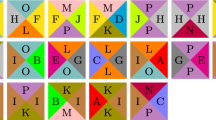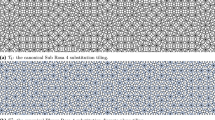Abstract
Jeandel and Rao proved that 11 is the size of the smallest set of Wang tiles, i.e., unit squares with colored edges, that admit valid tilings (contiguous edges of adjacent tiles have the same color) of the plane, none of them being invariant under a nontrivial translation. We study herein the Wang shift \(\Omega _0\) made of all valid tilings using the set \(\mathcal {T}_0\) of 11 aperiodic Wang tiles discovered by Jeandel and Rao. We show that there exists a minimal subshift \(X_0\) of \(\Omega _0\) such that every tiling in \(X_0\) can be decomposed uniquely into 19 distinct patches of size ranging from 45 to 112 that are equivalent to a set of 19 self-similar aperiodic Wang tiles. We suggest that this provides an almost complete description of the substitutive structure of Jeandel–Rao tilings, as we believe that \(\Omega _0{\setminus } X_0\) is a null set for any shift-invariant probability measure on \(\Omega _0\). The proof is based on 12 elementary steps, 10 of which involve the same procedure allowing one to desubstitute Wang tilings from the existence of a subset of marker tiles, while the other 2 involve addition decorations to deal with fault lines and changing the base of the \(\mathbb {Z}^2\)-action through a shear conjugacy. Algorithms are provided to find markers, recognizable substitutions, and shear conjugacy from a set of Wang tiles.
















Similar content being viewed by others
References
Akiyama, S., Tan, B., Yuasa, H.: On B. Mossé’s unilateral recognizability theorem (2017). arXiv:1801.03536
Audemard, G., Simon, L.: Glucose SAT solver (2019). https://www.labri.fr/perso/lsimon/glucose/
Baake, M., Grimm, U.: Aperiodic Order. Vol. 1. Encyclopedia of Mathematics and Its Applications, vol. 149. Cambridge University Press, Cambridge (2013)
Baake, M., Roberts, J.A.G., Yassawi, R.: Reversing and extended symmetries of shift spaces. Discrete Contin. Dyn. Syst. 38(2), 835–866 (2018)
Berger, R.: The undecidability of the Domino Problem. Ph.D. Thesis, Harvard University (1965)
Berthé, V., Delecroix, V.: Beyond substitutive dynamical systems: \(S\)-adic expansions. In: Akiyama, S., et al. (eds.) Numeration and Substitution 2012. RIMS Kôkyûroku Bessatsu, vol. B46, pp. 81–123. Research Institute for Mathematical Sciences (RIMS), Kyoto (2014)
Berthé, V., Rigo, M. (eds.): Combinatorics, Automata and Number Theory. Encyclopedia of Mathematics and Its Applications, vol. 135. Cambridge University Press, Cambridge (2010)
Berthé, V., Steiner, W., Thuswaldner, J., Yassawi, R.: Recognizability for sequences of morphisms (2017). arXiv:1705.00167
Boyle, M., Tomiyama, J.: Bounded topological orbit equivalence and \(C^*\)-algebras. J. Math. Soc. Jpn. 50(2), 317–329 (1998)
Charlier, E., Kärki, T., Rigo, M.: Multidimensional generalized automatic sequences and shape-symmetric morphic words. Discrete Math. 310(6–7), 1238–1252 (2010)
Chen, H.-H., Hu, W.-G., Lai, D.-J., Lin, S.-S.: Decidability of plane edge coloring with three colors (2012). arXiv:1210.6712
Culik II, K.: An aperiodic set of \(13\) Wang tiles. Discrete Math. 160(1–3), 245–251 (1996)
Frank, N.P.: Introduction to hierarchical tiling dynamical systems. In: Tiling and Recurrence. CIRM, Marseille (2017)
Frank, N.P., Sadun, L.: Fusion: a general framework for hierarchical tilings of \(\mathbb{R}^d\). Geom. Dedicata 171, 149–186 (2014)
Gähler, F., Julien, A., Savinien, J.: Combinatorics and topology of the Robinson tiling. C. R. Math. Acad. Sci. Paris 350(11–12), 627–631 (2012)
Grünbaum, B., Shephard, G.C.: Tilings and Patterns. W. H. Freeman and Company, New York (1987)
Gurobi Optimization, L.: Gurobi optimizer reference manual (2018). http://www.gurobi.com
Jeandel, E.: Undecidability of the domino problem. In: Tiling and Recurrence. CIRM, Marseille (2017)
Jeandel, E., Rao, M.: An aperiodic set of 11 Wang tiles (2015). arXiv:1506.06492
Kari, J.: A small aperiodic set of Wang tiles. Discrete Math. 160(1–3), 259–264 (1996)
Knuth, D.E.: The Art of Computer Programming. Vol. 1: Fundamental Algorithms. 2nd printing. Addison-Wesley, Reading (1969)
Knuth, D.E.: Dancing links. In: Millenial Perspectives in Computer Science, pp. 187–214 (2000). arXiv:cs/0011047
Labbé, S.: Optional SageMath Package slabbe (Version 0.6) (2019). https://pypi.python.org/pypi/slabbe/
Labbé, S.: SageMath Jupyter notebook (2019). https://nbviewer.jupyter.org/url/www.slabbe.org/Publications/arxiv_1808_07768_v4.ipynb
Labbé, S.: A self-similar aperiodic set of 19 Wang tiles. Geom. Dedicata 201, 81–109 (2019)
Lind, D., Marcus, B.: An Introduction to Symbolic Dynamics and Coding. Cambridge University Press, Cambridge (1995)
Mossé, B.: Puissances de mots et reconnaissabilité des points fixes d’une substitution. Theor. Comput. Sci. 99(2), 327–334 (1992)
Mozes, S.: Tilings, substitution systems and dynamical systems generated by them. J. Anal. Math. 53, 139–186 (1989)
Ollinger, N.: Two-by-two substitution systems and the undecidability of the domino problem. In: Beckmann, A., et al. (eds.) Logic and Theory of Algorithms. Lecture Notes in Computer Science, vol. 5028, pp. 476–485. Springer, Berlin (2008)
Queffélec, M.: Substitution Dynamical Systems—Spectral Analysis. Lecture Notes in Mathematics, vol. 1294, 2nd edn. Springer, Berlin (2010)
Robinson, R.M.: Undecidability and nonperiodicity for tilings of the plane. Invent. Math. 12, 177–209 (1971)
Sadun, L.: Topology of Tiling Spaces. University Lecture Series, vol. 46. American Mathematical Society, Providence (2008)
Sage Developers. SageMath, the Sage Mathematics Software System (Version 8.9) (2019). http://www.sagemath.org
Schmidt, K.: Multi-dimensional symbolic dynamical systems. In: Marcus, B., Rosenthal, J. (eds.) Codes, Systems, and Graphical Models. The IMA Volumes in Mathematics and Its Applications, vol. 123, pp. 67–82. Springer, New York (2001)
Siefken, J.: A minimal subsystem of the Kari–Culik tilings. Ergodic Theory Dyn. Syst. 37(5), 1607–1634 (2017)
Solomyak, B.: Dynamics of self-similar tilings. Ergodic Theory Dyn. Syst. 17(3), 695–738 (1997)
Solomyak, B.: Nonperiodicity implies unique composition for self-similar translationally finite tilings. Discrete Comput. Geom. 20(2), 265–279 (1998)
Wang, H.: Proving theorems by pattern recognition. II. Bell Syst. Tech. J. 40(1), 1–41 (1961)
Acknowledgements
I want to thank Vincent Delecroix for many helpful discussions at LaBRI in Bordeaux during the preparation of this article, including some hints on how to prove Proposition 11.5. I am grateful to Michaël Rao for providing me with the first proof of Proposition 5.2. This contribution would not have been possible without the Gurobi linear program solver [17], which was very helpful in solving many instances of tiling problems in seconds (instead of minutes or hours), but it turns out that Knuth’s dancing links algorithm [22] performs well to find markers. I acknowledge financial support from the Laboratoire International Franco-Québécois de Recherche en Combinatoire (LIRCO), the Agence Nationale de la Recherche Agence Nationale de la Recherche through the project CODYS (ANR-18-CE40-0007), and the Horizon 2020 European Research Infrastructure project OpenDreamKit (676541). I am very grateful to the anonymous referees for their in-depth reading and valuable comments, from which I learned and that led to a great improvement of the presentation. The revision of the article benefited from the support of the Erwin Schrödinger International Institute for Mathematics and Physics during my stay at the conference Numeration 2019 (Vienna).
Author information
Authors and Affiliations
Corresponding author
Additional information
Editor in Charge: Kenneth Clarkson
Publisher's Note
Springer Nature remains neutral with regard to jurisdictional claims in published maps and institutional affiliations.
Appendix
Appendix
The morphism \(\eta \,\omega _6\,\omega _7\,\omega _8 \,\omega _9\,\omega _{10}\,\omega _{11}\,\rho :\Omega _\mathcal {U}\rightarrow \Omega _5\) is recognizable and onto up to a shift. The map \(\jmath :\Omega _5\rightarrow \Omega _4\) then replaces horizontal colors 5 and 6 by 1 and 0, respectively, which creates horizontal fault lines of 0’s in the image of tiles numbered 1, 5, and 6 and horizontal fault lines of 1’s in the images of tiles numbered 8, 15, and 16
Rights and permissions
About this article
Cite this article
Labbé, S. Substitutive Structure of Jeandel–Rao Aperiodic Tilings. Discrete Comput Geom 65, 800–855 (2021). https://doi.org/10.1007/s00454-019-00153-3
Received:
Revised:
Accepted:
Published:
Issue Date:
DOI: https://doi.org/10.1007/s00454-019-00153-3







